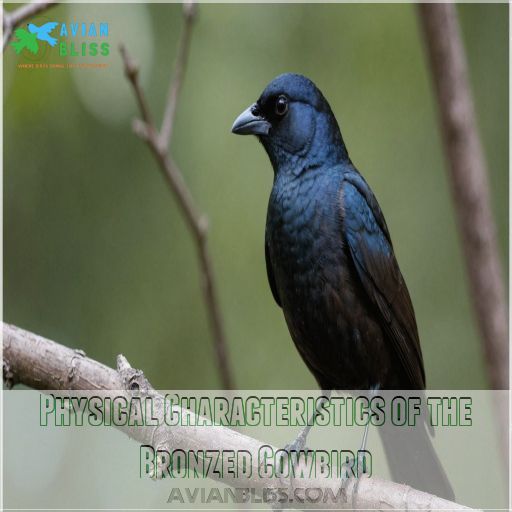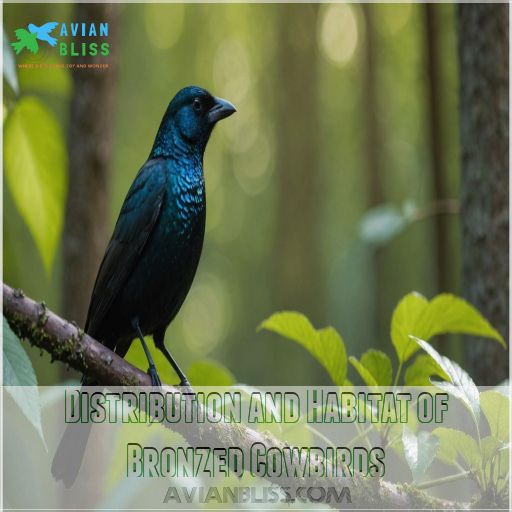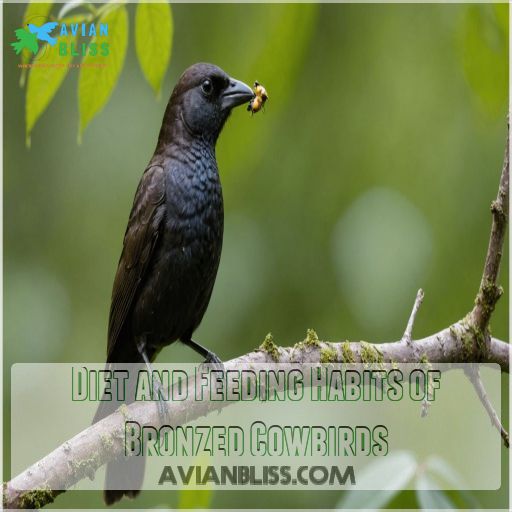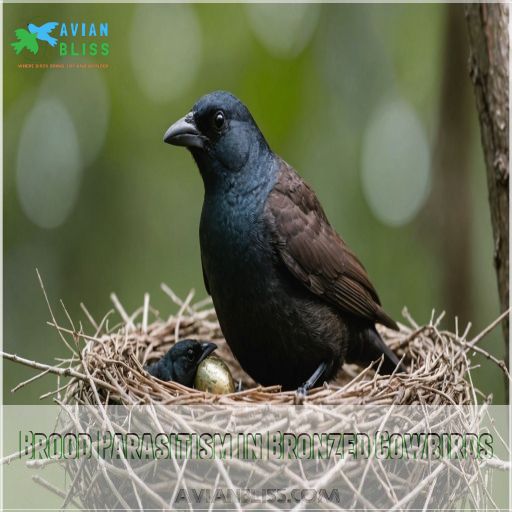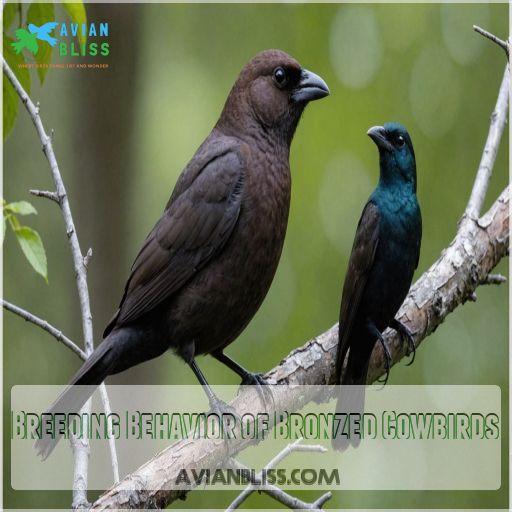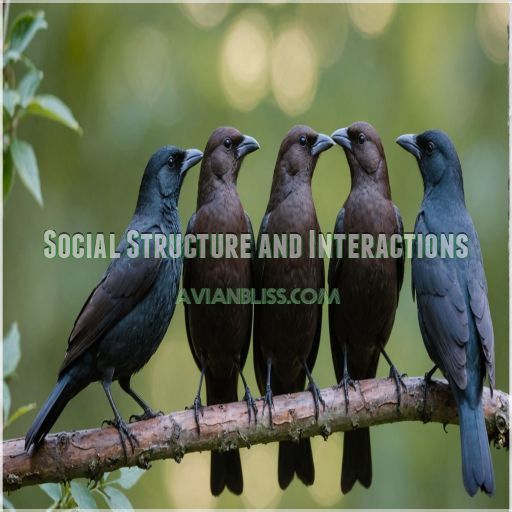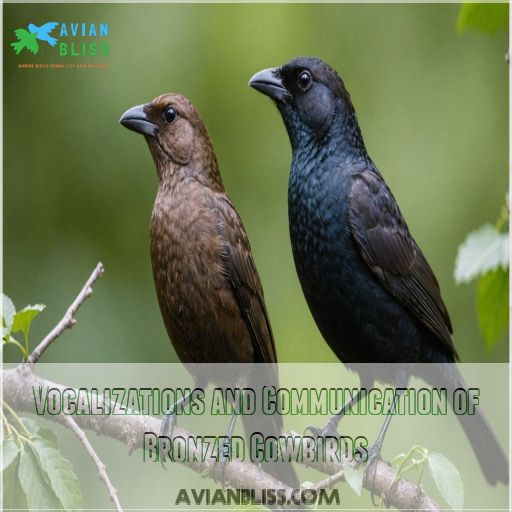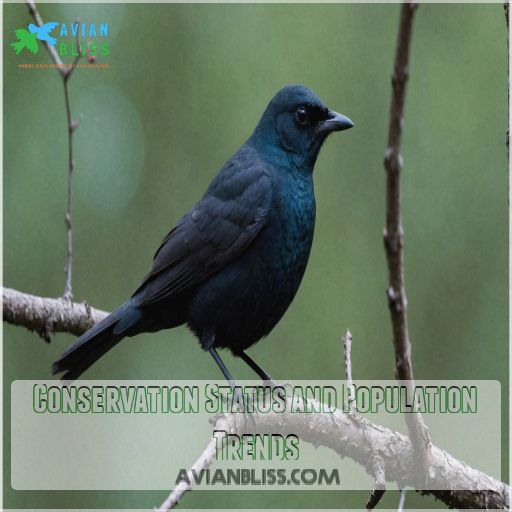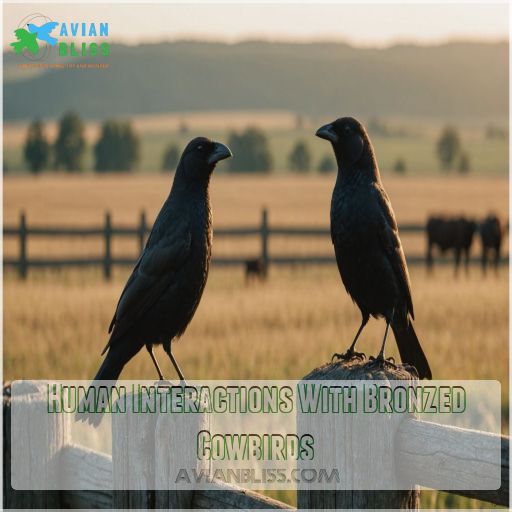This site is supported by our readers. We may earn a commission, at no cost to you, if you purchase through links.
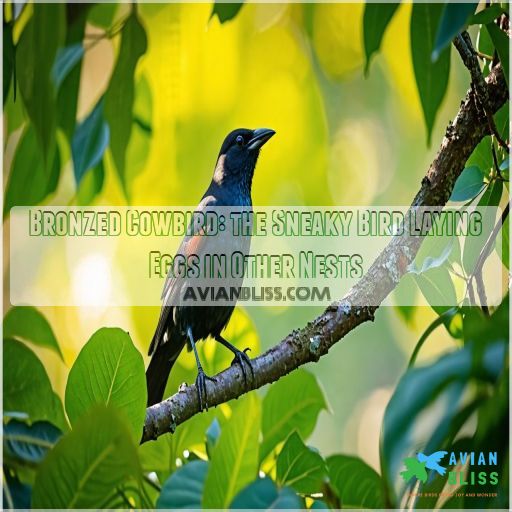
Found from the southern U.S. all the way to Central America, these birds are experts at laying eggs in other birds’ nests.
Males dazzle with glossy green-bronze feathers and those striking red eyes during the breeding season, while females stay more under the radar with their plain black look.
They hang around open woodlands and grasslands, often where cattle roam, snapping up insects for snacks.
But the twist? Their brood parasitism means they’re levying a hefty parenting fee on over 220 other bird species.
Curious about their odd breeding rituals? There’s more to the story. Bronzed cowbirds may also engage in brood parasitism in a different way than other birds, which adds to their unique characteristics.
Table Of Contents
- Key Takeaways
- Physical Characteristics of the Bronzed Cowbird
- Distribution and Habitat of Bronzed Cowbirds
- Diet and Feeding Habits of Bronzed Cowbirds
- Brood Parasitism in Bronzed Cowbirds
- Breeding Behavior of Bronzed Cowbirds
- Social Structure and Interactions
- Vocalizations and Communication of Bronzed Cowbirds
- Conservation Status and Population Trends
- Ecological Role of Bronzed Cowbirds
- Human Interactions With Bronzed Cowbirds
- Frequently Asked Questions (FAQs)
- What does a bronzed cowbird look like?
- Where do bronzed cowbirds live?
- Are bronzed cowbirds common in Arizona?
- Where is the bronze-brown cowbird found?
- What is the difference between bronzed cowbirds and Brown-headed Cowbirds?
- Are bronzed cowbirds brood parasites?
- Why do the bronzed cowbird and oriole live together?
- How big are bronzed cowbirds?
- How do bronzed cowbirds impact local agriculture?
- What are the migration patterns of bronzed cowbirds?
- How do bronzed cowbirds choose their host species?
- What are the unique challenges of studying bronzed cowbirds?
- How have climate changes affected bronzed cowbirds?
- Conclusion
Key Takeaways
- You’ll find that bronzed cowbirds are like those crafty friends who always manage to snag an invite to a party—they lay eggs in other birds’ nests, making the host species unknowingly raise their young while they live the carefree life.
- Spotting a bronzed cowbird is a treat—they sport shimmery black feathers with a bronze gleam and striking red eyes. It’s as if they hit the bird fashion jackpot. Males dazzle during breeding season, while females keep it low-key with their brownish look.
- These birds are true opportunists, whether it’s for so-called “free” parenting or food. They follow cattle to scoop up insects, proving they’ve got the art of being in the right place at the right time down to a science.
- Despite their parasitic reputation, bronzed cowbirds play unexpected roles in ecosystems by helping control insect populations and even spreading seeds, though sometimes unintentionally stirring the pot for host species.
Physical Characteristics of the Bronzed Cowbird
You’ll spot a bronzed cowbird by its distinctive metallic plumage and medium size, measuring about 7 inches in length with a wingspan of up to 14 inches.
Males are slightly larger and more colorful than females, with glossy green-bronze feathers and red eyes during breeding season, while females sport dull black plumage and brown eyes year-round.
Size and Weight
With a weight of 2.3-2.6 oz and a length of 7.9 inches, you’ll find the Bronzed Cowbird to be a medium-sized bird that packs a punch.
It’s slightly larger than its cousin, the Brown-headed Cowbird, but smaller than a meadowlark.
You’ll notice some size variation between individuals and subspecies. The Arizona subspecies, loyei, is the largest, while the endangered armenti from Colombia is the smallest.
Keep an eye out for sexual dimorphism in size!
Plumage Coloration
You’ll be mesmerized by the bronzed cowbird’s striking plumage. Its metallic sheen isn’t just for show—it’s a reflection of evolutionary adaptations.
Let’s explore this bird’s color palette:
- Iridescent neck feathers that shimmer like liquid metal
- Striking black eyes that seem to pierce your soul
- A subtle contrast of pale buff and brown underbelly
These colors aren’t static. Seasonal changes and molting patterns create a dynamic canvas, showcasing nature’s artistry in motion.
Sexual Dimorphism
Bronzed Cowbirds stand out with their striking sexual dimorphism. Males sport a glossy, iridescent plumage that gleams in the sunlight, while females don a more subdued brownish-gray attire.
This plumage difference plays a key role in mating strategies and courtship displays. During breeding season, males’ feathers become even more vibrant, helping them catch the eye of potential mates.
The distinct appearance aids in species identification and reflects evolutionary pressures shaping these nest parasites’ unique lifestyle.
Eye Color Variations
Eye color in Bronzed Cowbirds is a real eye-opener. These birds sport striking yellow eyes that serve multiple functions.
During breeding season, their eye color intensifies, playing a key role in courtship displays and threat postures. It’s not just for show – eye color variation may also help with visual acuity and light sensitivity.
Notably, eye color genetics in birds can be quite complex, with different mechanisms producing similar hues across species, making eye color variation a fascinating area of study.
Juvenile Appearance
Fledgling Bronzed Cowbirds sport a different look from their striking adult counterparts. You’ll notice these youngsters resemble adult females, donning brownish-gray plumage that helps them blend in with their surroundings. Unlike the females, though, they lack pale underparts.
As they grow, their feathers gradually transform, revealing the species’ signature iridescent sheen. This camouflage serves them well, protecting them as they develop into their adult form.
Female cowbirds, including Bronzed Cowbirds, often engage in brood parasitism, laying their eggs in other birds’ nests, which can be a conservation concern. Their brownish-gray plumage, similar to that of the fledglings, also helps them blend in with their surroundings, allowing them to silently observe potential host nests.
Distribution and Habitat of Bronzed Cowbirds
You’ll find bronzed cowbirds across a vast range, from Argentina to Canada, favoring open woodlands and grasslands with scattered trees.
These adaptable birds also thrive in agricultural fields, pastures, and suburban yards, migrating north-south annually and seeking habitats with ample food sources and fresh water.
Geographical Range
You’ll find these crafty birds flitting across a vast expanse. The Bronzed Cowbird‘s distribution range stretches from the southern United States to Central America. Their annual north-south migration pattern is a sight to behold.
Let’s break down their geographical range:
- Year-round residents in South Texas Brush Country
- Breeding populations in Arizona and New Mexico
- Established colonies in New Orleans and west Florida
- Winter migrants heading south into Mexico
These adaptable creatures are expanding their territory, keeping ornithologists on their toes!
Preferred Ecosystems
Bronzed Cowbirds have a knack for finding their ideal home sweet home. These adaptable birds thrive in a variety of ecosystems, from wide-open grasslands to cozy woodland edges.
Let’s take a peek at their preferred hangouts:
| Habitat Type | Bronzed Cowbird Preferences |
|---|---|
| Open Areas | Agricultural fields, pastures |
| Brushy Spots | Mesquite woodlands, shrublands |
| Urban Spaces | Golf courses, suburbs |
| Woodlands | Riparian corridors, wooded canyons |
| Elevations | Up to 8,200 feet in tropical forests |
These birds aren’t picky eaters, which helps them adapt to various habitats.
Seasonal Migration Patterns
When do these sneaky birds begin their seasonal journeys?
Bronzed Cowbirds typically migrate south from the United States into Mexico during winter. They respond to environmental cues, leaving their breeding grounds in search of warmer wintering habitats.
You’ll find year-round residents in South Texas and the lower Rio Grande valley.
Their flight routes take them to coastal areas, where they join flocking behaviors with other blackbird species.
Adaptations to Urban Environments
In the concrete jungle, Bronzed Cowbirds have become urban chameleons, adapting to city life with surprising finesse. They’ve learned to thrive in suburban yards, joining mixed-species flocks and taking advantage of urban food sources.
These savvy birds have developed a knack for:
- Selecting nest sites in noise-tolerant host species
- Perching on man-made structures like telephone wires
- Embracing a flock mentality for safety in numbers
Their resilience in human-dominated landscapes showcases nature’s remarkable ability to evolve with our ever-changing world.
Diet and Feeding Habits of Bronzed Cowbirds
You’ll find bronzed cowbirds munching on a diverse menu of insects, fruits, grains, and seeds.
These versatile eaters often forage on the ground near cattle, snatching up insects disturbed by the animals’ movements.
They sometimes help themselves to the livestock’s grain feed.
Primary Food Sources
You’ll find bronzed cowbirds have quite the varied menu. Their primary food sources include seeds from grasses and weeds, along with a hearty helping of insects. These opportunistic eaters aren’t picky, adapting their diet to seasonal availability.
They may also visit backyard feeding stations that offer safe alternatives like unsalted peanuts or sunflower seeds, which provide a nutritious snack option, and it’s essential to be aware of the dangers of salted peanut toxicity.
In winter, they’ll flock to agricultural fields for crop grains, while summer brings a buffet of beetles and grasshoppers. Don’t be surprised to spot them at backyard feeding stations, too!
Foraging Techniques
Bronzed Cowbirds employ a variety of clever foraging techniques to satisfy their diverse appetites.
You’ll often spot these opportunistic feeders strutting on the ground, rapidly walking and stopping to snatch up seeds or insects with their sharp bills.
They’re not afraid to get creative, either – these birds will boldly strip grain from stalks and even pluck ticks off livestock, proving they’re masters of adaptation in their open woodland habitats.
Seasonal Diet Variations
Seasonal shifts shape the Bronzed Cowbird’s menu. As you’d expect, these adaptable birds aren’t picky eaters. They’ll switch from seeds to insects faster than you can say "food chain."
Here’s how they keep their plates full year-round:
- Winter woes: Seeds become the main course, making up over 90% of their diet
- Spring fling: Insects take center stage as abundance increases
- Summer smorgasbord: A mix of seeds, insects, and fruits keeps things interesting
These clever birds know how to roll with the seasons!
Interactions With Cattle
While their diet shifts with the seasons, bronzed cowbirds have a special knack for finding food near cattle.
You’ll often spot these clever birds following herds, snatching up insects stirred by hooves. It’s a win-win situation – the cowbirds get an easy meal, and the cattle get pest control.
This cattle-bird relationship shapes their feeding habits and helps them thrive in pastures and feedlots across their range.
Brood Parasitism in Bronzed Cowbirds
You’re about to discover the sneaky strategy of bronzed cowbirds: they’re brood parasites who lay their eggs in other birds’ nests.
This crafty behavior allows them to outsource parental care, impacting host populations and showcasing a fascinating example of evolutionary adaptation.
Host Species Selection
You might be surprised to learn that Bronzed Cowbirds are picky when it comes to choosing their unwitting foster parents. These sneaky birds have a knack for selecting the perfect hosts for their eggs. Here’s what you need to know about their host species selection:
- They target over 220 different North American bird species like the Brown-headed Cowbird’s hosts
- Hooded Orioles are frequent victims of their parasitism
- They often choose nests in open habitats like pastures and golf courses
- Host preferences vary based on local availability and success rates, often influenced by the open habitats they thrive in, such as farmlands and grasslands, which provide an ideal environment for foraging and breeding.
- Some host species, like the Brown-Headed Cowbird, have even adapted to the presence of cattle, which can impact their host selection and overall ecosystem dynamics.
- Some hosts, like the Altamira Oriole, may be more vulnerable to parasitism
Egg-Laying Strategies
Stealth and precision characterize the bronzed cowbird’s egg-laying strategies. These clever birds have mastered the art of brood parasitism, sneaking their eggs into other birds’ nests.
Let’s take a closer look at their tactics:
| Strategy | Description |
|---|---|
| Host selection | Targets specific species |
| Egg mimicry | Matches host egg appearance |
| Timing | Lays during host’s absence |
| Removal | Often removes host egg |
| Vigilance | Monitors nest for success |
Their egg-laying prowess is truly impressive, ensuring their genes live on through unsuspecting foster parents.
Impact on Host Populations
How does the bronzed cowbird’s sneaky egg-laying affect its unwitting hosts?
This feathered freeloader can dramatically decrease host species’ hatching and fledging success .
You’ll find that brood parasitism often leads to nest failures, with studies showing it causes up to 57% of nest losses in some populations.
The parasites’ presence creates fierce nest competition, reducing survival rates of host chicks and putting evolutionary pressure on breeding success.
It’s a tough break for the hardworking host birds, facing nest failures.
Evolutionary Adaptations
Nature’s grand design has equipped bronzed cowbirds with remarkable evolutionary adaptations for brood parasitism.
These clever birds have developed thicker eggshells to withstand host rejection. They’ve also fine-tuned their egg-laying timing to match host cycles and honed their ability to select suitable nests.
Through a fascinating co-evolutionary dance, bronzed cowbirds continue to outsmart their hosts, ensuring their own survival while challenging the defenses of other species with their remarkable ability to outsmart their hosts.
Breeding Behavior of Bronzed Cowbirds
You’ll find bronzed cowbirds’ breeding behavior fascinating, as they employ a promiscuous mating system with both males and females having multiple partners.
During the breeding season from April to August, males establish display areas that females visit regularly, showcasing their unique courtship rituals.
Mating System
The love lives of bronzed cowbirds are far from simple. You’ll find these feathered Casanovas living it up with multiple partners. Their mating system is promiscuous, with both males and females playing the field.
Here’s what you need to know about their complex social lives:
- Males outnumber females in most flocks
- Breeding pairs aren’t socially monogamous
- Mating rituals vary based on host nest density
This cowbird family’s breeding success depends on their adaptable approach to seasonal mating.
Courtship Displays
Bronzed cowbirds put on quite a show when it comes to courtship. You’ll see males puffing out their feathers, raising their neck ruff, and partially opening their black wings. It’s like they’re auditioning for a bird’s version of "Dancing with the Stars"!
Check out this breakdown of their elaborate mating ritual:
| Display Element | Description |
|---|---|
| Body Posture | Puffed out feathers, raised neck ruff |
| Wing Movement | Partially opened, vibrating |
| Tail Position | Dropped down |
| Vocalizations | Low, gurgling call |
| Aerial Display | Helicopter-like hover above female |
These displays aren’t just for show – they’re key for breeding success and female choice in southern Texas and beyond.
Breeding Season Timing
Sneaky egg-layers, you’ll find bronzed cowbirds timing their breeding season to perfection.
They kick off their parasitic nesting as early as May, with some females laying up to 40 eggs in a single season.
You’ll notice geographic variations in their timing, as climate change impacts their patterns.
These crafty birds select nest sites with scattered trees, adapting their breeding behavior to maximize success across their range.
Reproductive Success Rates
Egg-laying success rates of Bronzed Cowbirds (Molothrus aeneus) might surprise you.
While they’re sneaky nest parasites, only about 3% of their eggs result in adult birds (Source).
Despite this low success rate, these passerine birds continue to expand their range and numbers.
The coevolutionary pressures between cowbirds and their hosts create a fascinating dance of survival in riparian corridors and beyond.
You’ll find their resilience truly remarkable.
Social Structure and Interactions
You’ll find bronzed cowbirds to be social creatures, often forming flocks of up to 100 birds or more for foraging, resting, and roosting.
These gregarious birds display interesting social dynamics, with males outnumbering females in most flocks and exhibiting territorial behavior during mating displays.
Flock Dynamics
You’ll find these birds aren’t lone wolves. After breeding, bronzed cowbirds form flocks of varying sizes, often mixing with other blackbird species.
These social gatherings serve as avian classrooms, where young males learn the ropes from their elders. It’s like a bird’s version of networking!
Watch for their distinctive foraging patterns as they follow cattle, snatching up insects in a chicken scratch dance across golf courses and wooded canyons.
Territorial Behavior
The territorial world of Bronzed Cowbirds is a fascinating spectacle of male aggression and breeding displays.
You’ll witness these feathered Casanovas bow and distend their ruffs when confronting rivals. They’re not just showing off—it’s serious business.
Males fiercely defend their turf, often outnumbering females in flocks.
This territorial dance isn’t just about real estate; it’s a competition for food and potential mates.
Communication Methods
Bronzed Cowbirds aren’t just territorial; they’re also master communicators.
You’ll notice their repertoire of vocalizations, from soft chatter to loud squawks. These birds use a variety of non-vocal cues too, like wing displays and posturing.
Social signals play a key role in flock dynamics, helping establish hierarchies and maintain group cohesion.
During breeding season, listen for their distinctive mating calls – a sure sign that love is in the air!
Interspecies Relationships
Imagine you’re observing bronzed cowbirds as they navigate complex interspecies relationships.
They engage in:
- Host-parasite dynamics by laying eggs in other birds’ nests.
- Competitive foraging alongside other species.
- Predator-prey interactions within ecosystems.
- Mutualistic benefits with large grazing animals.
- Interspecific communication, essential for survival.
These interactions shape their unique role in nature.
Vocalizations and Communication of Bronzed Cowbirds
You’ll find that bronzed cowbirds use a diverse range of calls, with each type serving a specific function, from attracting mates to warding off rivals.
Their vocalizations also change with the seasons, highlighting their adaptability to different social and environmental needs, which also includes a change in vocalizations.
Call Types and Functions
Curious about the vocalizations of the bronzed cowbird? You’re in luck! These birds have an impressive repertoire, from mating calls to alarm signals.
Their calls serve essential functions, like attracting mates and defending territories.
Let’s explore the details, shall we? Get ready to be amazed by the vocal prowess of this fascinating species.
| Call Type | Description | Function |
|---|---|---|
| Mating Call | Low-pitched, gurgling sound | Attracts potential mates |
| Alarm Call | Harsh, scolding "chak" note | Warns of predators or intruders |
| Territorial Call | Loud, whistled "klee-dee" | Marks and defends breeding grounds |
| Social Call | Soft, chattering sounds | Maintains contact within flocks |
Seasonal Variations in Vocalizations
You’ll notice bronzed cowbirds’ songs change with the seasons. Their vocalizations shift to suit needs ranging from attracting mates to marking territory.
During breeding, lively mating calls fill the air, while winter brings softer calls for flock bonding.
Keep an ear out for:
- Lively chirps in summer
- Softer winter melodies
- Bold territorial songs
- Distinctive breeding tunes
- Collaborative group calls
Non-Vocal Communication Signals
Like a puppeteer pulling strings, the bronzed cowbird uses non-vocal cues to communicate.
You’ll notice their body language: wing movements and feather ruffling signal mood changes, while head bobbing often denotes curiosity.
Beak gestures, subtle yet effective, can express more complex intentions.
Understanding these signals adds depth to their social dynamics, revealing a language without words.
Conservation Status and Population Trends
You’ll find that the bronzed cowbird’s population is stable, estimated at around 6.6 million, thanks to its adaptability and wide range.
Despite its parasitic antics, this bird faces few significant threats, but researchers keep an eye on its impact on other species and any potential effects of climate change.
Current Population Estimates
Before exploring how these cowbirds chatter and communicate, let’s glance at their numbers.
Global estimates suggest about 6.6 million Bronzed Cowbirds with stable populations since 1966. Displaying low conservation concern, these birds thrive amidst habitat changes.
Their breeding success sometimes impacts host species, making them a fascinating study in ecological adaptations and persistence.
Threats to Bronzed Cowbirds
Although Bronzed Cowbirds are widespread, threats still loom.
You’ll observe these key challenges:
- Habitat loss: Their open fields shrink as development rises. Birds serve as reliable indicators of habitat quality, and changes in their populations can reveal the well-being of ecosystems. Tracking bird adaptations, like those of the Bronzed Cowbird, helps safeguard habitats avian indicators of ecosystem health.
- Climate change: Shifting climates alter migration and feeding patterns.
- Parasitism impact: Their parasitic nature strains relationships with other birds.
- Human interaction: Urban expansion affects their natural behaviors.
Stay informed and aware!
Conservation Efforts
From contending with threats, you pivot to positive actions.
Bronzed Cowbird populations remain stable, with a global count of 6.6 million, marked as low concern on the Conservation Score.
Key efforts include population monitoring and habitat preservation. Public awareness and research funding can mitigate negative impacts on hosts, ensuring these charismatic birds continue enhancing ecosystems without becoming problematic.
Impact of Climate Change
The bronzed cowbird’s range may shift as climate change alters its habitat.
You might notice food scarcity, disrupted migration patterns, and declining breeding success.
These challenges could impact the species’ conservation status and population trends.
To help, you can support habitat restoration efforts and report any sightings to local wildlife authorities.
Ecological Role of Bronzed Cowbirds
When you think of the bronzed cowbird’s ecological role, consider its knack for seed dispersal and controlling insect populations.
These birds also impact host bird ecosystems with their parasitic nesting habits, showing that nature doesn’t always play by the rules.
Seed Dispersal
You might wonder how bronzed cowbirds fit into the ecosystem.
While primarily focused on parasitizing nests, they inadvertently assist in seed dispersal.
Their foraging behavior often involves consuming seeds, which they scatter across various habitats.
This activity can impact plant distribution and also raises conservation concerns, as their spread sometimes challenges native plant habitats.
Insect Population Control
Bronzed Cowbirds, with their seed-eating habits, also help balance ecosystems by controlling insect populations, such as grasshoppers and beetles.
Their diet acts like nature’s pest control, promoting bird diversity and maintaining ecosystem balance.
So, as sneaky as they’re with seeds, they’re also busy munching on insects, playing an unexpected role in keeping those critters in check.
Impact on Host Species Ecosystems
Ever wondered how brood parasitism shakes up ecosystems? You’ll find that cowbirds often tip the balance.
Here’s how they do it:
- Host species decline: Cowbirds’ eggs win, leaving fewer resources for host chicks.
- Nest competition: Space becomes a battlefield.
- Brood parasitism effects: Host parents raise invaders.
- Evolutionary adaptations: Host birds develop defenses.
Human Interactions With Bronzed Cowbirds
You might encounter bronzed cowbirds in agricultural areas, where their fondness for cattle feed can sometimes ruffle feathers among farmers.
Birdwatchers, however, enjoy spotting these cheeky cowbirds, contributing to ecotourism and adding a touch of avian drama to urban parks and backyards.
Agricultural Impacts
When you consider the agricultural impact of bronzed cowbirds, think of them as uninvited guests at a garden party.
They’re not just freeloading; their seed dispersal can benefit crops, while their pest control skills might impress you.
However, they can also cause crop damage and interact with livestock, contributing to habitat loss.
| Impact | Description |
|---|---|
| Crop Damage | Negative effect on yields |
| Seed Dispersal | Can aid plant growth |
| Pest Control | Helps manage insect pests |
Birdwatching and Ecotourism
As a birdwatcher, you’ll delight in spotting the Bronzed Cowbird’s distinctive red eye and sleek, black plumage.
These birds thrive in open habitats like pastures and golf courses, often associating with cattle.
To ethically observe them, visit ecotourism hotspots in the southern U.S. and Mexico, and use photography tips to capture their unique behaviors.
Cultural Significance
Spotting bronzed cowbirds can be a treat for birdwatchers.
Beyond the binoculars, these birds feature in folklore and mythology, symbolizing adaptability.
Their crafty nesting habits intrigue scientists and inspire art and literature, depicting nature’s quirks.
It’s fascinating how such a small bird can flutter into cultural narratives, blending seamlessly with human stories.
Management in Urban Areas
You recognize the nuanced cultural significance of bronzed cowbirds. Now picture urban areas where these sneaky birds clash with human interests.
Their adaptability in cities can also raise concerns about their impact on native species, potentially mirroring the effects of caging birds and their natural behavior.
To tackle this, consider:
- Urban habitat impact – they thrive in cities.
- Food source competition – they outcompete native birds.
- Human-bird conflict – manage nesting site choices for balance.
Human interactions offer intriguing challenges and opportunities.
Frequently Asked Questions (FAQs)
What does a bronzed cowbird look like?
A bronzed cowbird, like a gemstone in sunlight, sports a velvety black body with a bronze shimmer and intense red eyes.
Males display shimmering blue wings, while females are grayish brown or black, depending on subspecies.
Where do bronzed cowbirds live?
Bronzed Cowbirds inhabit open areas like agricultural fields and mesquite woodlands in the U.S., particularly Texas and Arizona.
They also live in Central America, tropical forests, and even suburban areas with backyard feeders.
Are bronzed cowbirds common in Arizona?
While not as common as in Texas, bronzed cowbirds have established breeding populations in the open habitats and wooded canyons of Arizona and New Mexico.
Some wandering individuals have been reported in other parts of the state as well.
Where is the bronze-brown cowbird found?
The bronze-brown cowbird, often considered a separate species, is primarily found in Colombia.
It inhabits open regions and often associates with other cowbird species, which are known for their brood parasitic behavior.
What is the difference between bronzed cowbirds and Brown-headed Cowbirds?
Males differ with Brown-headed Cowbirds sporting brown heads and Bronzed Cowbirds having red eyes and bluish wings.
Bronzed are larger, thriving in open fields, while Brown-headed favor more varied habitats.
They often act as brood parasites in these varied habitats, which is a key characteristic of Brown-headed Cowbirds.
Are bronzed cowbirds brood parasites?
Bronzed cowbirds are indeed brood parasites.
It means they lay eggs in other birds’ nests, letting host species unwittingly raise their chicks.
This clever trick spares cowbirds from the hard work of parenting entirely.
Why do the bronzed cowbird and oriole live together?
Cowbirds and orioles coexist because bronzed cowbirds lay eggs in oriole nests, exploiting them for parental duties.
This parasitic relationship affects oriole populations as they unknowingly raise cowbird chicks, often at the expense of their own young (Source).
How big are bronzed cowbirds?
Imagine a bird the size of imagination unfurling wings.
Bronzed Cowbirds measure about 9 inches long with a 13-inch wingspan.
These small yet robust birds weigh between 3 to 6 ounces, slightly larger than their Brown-headed cousins.
How do bronzed cowbirds impact local agriculture?
Cowbirds, including bronzed ones, impact local agriculture by parasitizing songbird nests, which can lower songbird populations.
This indirect effect may alter pest control dynamics through pest management strategies, potentially increasing agricultural pests and affecting crop yields
.
What are the migration patterns of bronzed cowbirds?
Ah, the irony – these feathered nomads roam far and wide, yet their wanderlust knows no bounds!
From grasslands to backyards, their migration patterns are as diverse as the landscapes they grace.
How do bronzed cowbirds choose their host species?
Bronzed cowbirds choose host species by targeting active nests of various birds, often picking those similar to their mother’s choice.
They favor species like orioles, thrashers, and smaller birds, making strategic decisions to maximize survival.
What are the unique challenges of studying bronzed cowbirds?
Exploring the "wild west" of Bronzed Cowbird research, you’ll encounter their secretive nesting behavior.
Their secretive nesting behavior and host diversity make them unique.
These cowbirds mimic local species and choose varied nests, making it tough to track interactions and impacts accurately (Source).
How have climate changes affected bronzed cowbirds?
Climate changes impact bronzed cowbirds by shifting their habitats and altering food availability, which affects their behavior and parasitic relationships.
These adjustments can lead to increased competition for resources and influence their geographical distribution.
Conclusion
Surprisingly, bronzed cowbirds rely on over 220 bird species to raise their young, making them true experts in brood parasitism.
As you watch these stealthy birds flit through grasslands and urban settings, remember they’re not just freeloaders—they play a role in controlling insect populations and affecting ecological balances.
So, while their sneaky parenting might seem unfair, it’s part of their unique survival strategy and adds a layer of intrigue to birdwatching adventures.

